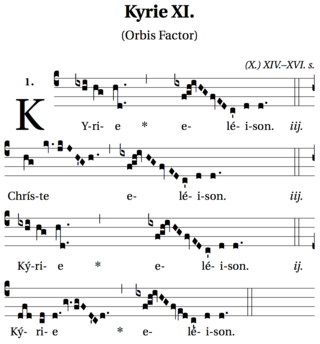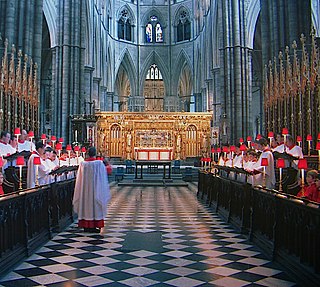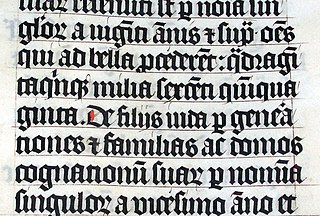Da capo is an Italian musical term that means "from the beginning". The term is a directive to repeat the previous part of music, often used to save space, and thus is an easier way of saying to repeat the music from the beginning.
In computer science, extended Backus–Naur form (EBNF) is a family of metasyntax notations, any of which can be used to express a context-free grammar. EBNF is used to make a formal description of a formal language such as a computer programming language. They are extensions of the basic Backus–Naur form (BNF) metasyntax notation. The earliest EBNF was developed by Niklaus Wirth, incorporating some of the concepts from Wirth syntax notation. Today, many variants of EBNF are in use. The International Organization for Standardization adopted an EBNF Standard, ISO/IEC 14977, in 1996. According to Zaytsev, however, this standard "only ended up adding yet another three dialects to the chaos" and, after noting its lack of success, also notes that the ISO EBNF is not even used in all ISO standards. Wheeler argues against using the ISO standard when using an EBNF and recommends considering alternative EBNF notations such as the one from the W3C Extensible Markup Language (XML) 1.0 . This article uses EBNF as specified by the ISO for examples applying to all EBNFs. Other EBNF variants use somewhat different syntactic conventions.

Gregorian chant is the central tradition of Western plainchant, a form of monophonic, unaccompanied sacred song in Latin of the Roman Catholic Church. Gregorian chant developed mainly in western and central Europe during the 9th and 10th centuries, with later additions and redactions. Although popular legend credits Pope Gregory I with inventing Gregorian chant, scholars believe that it arose from a later Carolingian synthesis of the Old Roman chant and Gallican chant.
In music, a coda is a passage that brings a piece to an end. It may be as simple as a few measures, or as complex as an entire section.
A variety of musical terms are encountered in printed scores, music reviews, and program notes. Most of the terms are Italian, in accordance with the Italian origins of many European musical conventions. Sometimes, the special musical meanings of these phrases differ from the original or current Italian meanings. Most of the other terms are taken from French and German, indicated by Fr. and Ger., respectively.
In musical notation, a bar is a segment of music bounded by vertical lines, known as bar lines, usually indicating one or more recurring beats. The length of the bar, measured by the number of note values it contains, is normally indicated by the time signature.
In music notation, dal segno, often abbreviated as D.S., is used as a navigation marker. Defined as "from the sign" in Italian, D.S. appears in sheet music and instructs a musician to repeat a passage starting from the sign shown at right, sometimes called the segno in English.
The numero sign or numero symbol, № (also represented as Nº, No̱, №,No. or no.), is a typographic abbreviation of the word number(s) indicating ordinal numeration, especially in names and titles. For example, using the numero sign, the written long-form of the address "Number 29 Acacia Road" is shortened to "№ 29 Acacia Rd", yet both forms are spoken long.

Braille music is a braille code that allows music to be notated using braille cells so music can be read by visually impaired musicians. The system was incepted by Louis Braille.

Kyrie, a transliteration of Greek Κύριε, vocative case of Κύριος (Kyrios), is a common name of an important prayer of Christian liturgy, also called the Kyrie eleison.
The numbered musical notation is a cipher notation system used in Mainland China, Taiwan, Hong Kong, and to some extent in Japan, Indonesia, Malaysia, Australia, Ireland, the United Kingdom, the United States and English-speaking Canada. It dates back to the system designed by Pierre Galin, known as Galin-Paris-Chevé system. It is also known as Ziffernsystem, meaning "number system" or "cipher system" in German.

Anglican chant, also known as English chant, is a way to sing unmetrical texts, including psalms and canticles from the Bible, by matching the natural speech-rhythm of the words to the notes of a simple harmonized melody. This distinctive type of chant is a significant element of Anglican church music.

Scribal abbreviations, or sigla, are abbreviations used by ancient and medieval scribes writing in various languages, including Latin, Greek, Old English and Old Norse.

A fermata is a symbol of musical notation indicating that the note should be prolonged beyond the normal duration its note value would indicate. Exactly how much longer it is held is up to the discretion of the performer or conductor, but twice as long is common. It is usually printed above but can be occasionally below the note to be extended.

Mensural notation is the musical notation system used for polyphonic European vocal music from the late 13th century until the early 17th century. The term "mensural" refers to the ability of this system to describe precisely measured rhythmic durations in terms of numerical proportions amongst note values. Its modern name is derived from the terminology of medieval theorists, who used terms like musica mensurata or cantus mensurabilis to refer to the rhythmically defined polyphonic music of their age, as opposed to musica plana or musica choralis, i.e., Gregorian plainchant. Mensural notation was employed principally for compositions in the tradition of vocal polyphony, whereas plainchant retained its own, older system of neume notation throughout the period. Besides these, some solely instrumental music could be written in various forms of instrument-specific tablature notation.
An overline, overscore, or overbar, is a typographical feature of a horizontal line drawn immediately above the text. In old mathematical notation, an overline was called a vinculum, a notation for grouping symbols which is expressed in modern notation by parentheses, though it persists for symbols under a radical sign. The original use in Ancient Greek was to indicate compositions of Greek letters as Greek numerals. In Latin, it indicates Roman numerals multiplied by a thousand and it forms medieval abbreviations (sigla). Marking one or more words with a continuous line above the characters is sometimes called overstriking, though overstriking generally refers to printing one character on top of an already-printed character.
Ambrosian chant is the liturgical plainchant repertory of the Ambrosian rite of the Roman Catholic Church, related to but distinct from Gregorian chant. It is primarily associated with the Archdiocese of Milan, and named after St. Ambrose much as Gregorian chant is named after Gregory the Great. It is the only surviving plainchant tradition besides the Gregorian to maintain the official sanction of the Roman Catholic Church.
In music, the conclusion is the ending of a composition and may take the form of a coda or outro.
The ditto mark is a shorthand sign, used mostly in hand-written text, indicating that the words or figures above it are to be repeated.
Abbreviations in music are of two kinds, namely, abbreviations of terms related to musical expression, and the true musical abbreviations by the help of which certain passages, chords, etc., may be notated in a shortened form, to the greater convenience of both composer and performer. Abbreviations of the first kind are like most abbreviations in language; they consist for the most part of the initial letter or first syllable of the word employed—as for instance, p or f for the dynamic markings piano and forte, cresc. for crescendo, Ob. for oboe, Fag. for bassoon. This article is about abbreviations used in music notation.

] is sometimes added. [1]







